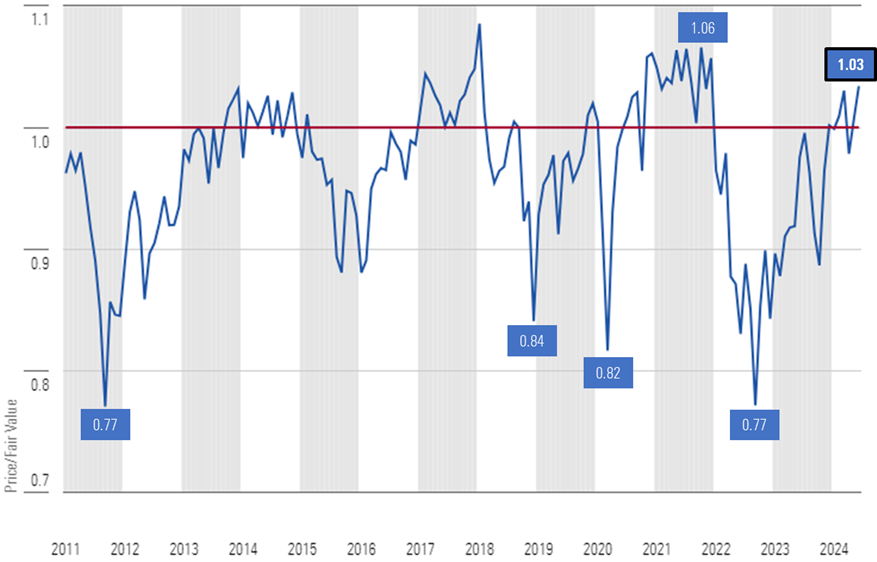20 Handy Reasons For Choosing AI Stock Prediction Websites
20 Handy Reasons For Choosing AI Stock Prediction Websites
Blog Article
Top 10 Tips To Evaluate The Strategy Customization Of AI stock Forecasting/Analyzing Trading Platforms
Strategy customization is a crucial characteristic of AI stock predicting/analyzing trading platforms which allows traders to tailor the platform to their own specific goals in trading and risk tolerance as well as market conditions. A platform that has a range of options for customization will improve your trading. Here are 10 suggestions to help you assess the capabilities of a platform to modify your strategy
1. Evaluate Pre-Built Strategy Templates
Variety of Templates: Verify if the trading platform has templates pre-built for different types of trading (e.g. Day Trading, Swing Trading, Long-Term Investment).
User-friendliness: Consider how easy it is to apply and modify these templates to suit your requirements.
Performance history: Confirm that the platform is able to provide past performance data for pre-built strategic plans.
2. Review the Custom Strategy Development
Drag-and-drop tools Find platforms that have intuitive drag-anddrop interfaces to create unique strategies.
Coding options: Check whether the platform allows customized coding (e.g., Python, R or any other scripting languages) for advanced users.
Flexibility: Make sure the platform lets you define entry/exit requirements as well as risk management parameters as well as other important elements of your strategy.
3. Check for Backtesting Capabilities
Historical data: Check whether your platform provides enough historical data to test strategies for backtesting.
Modifiable parameter: Make sure you have the ability to adjust parameters while backtesting (e.g. indicators and timeframes).
Performance metrics: Ensure that the platform offers detailed measures of performance (e.g. Win rate, Sharpe Ratio, Drawdown) when backtesting strategies.
4. Evaluate Real-Time Strategy Testing
Paper trading Strategies can be tested in real time using paper trading or simulation.
Live testing - See if you can test strategies with small amounts to see how they work.
Real-time adjustments: Check whether you're able to adjust your strategies in real time based on the market conditions.
5. Integrate Integration with Technical Indicators
Find out if there's an indicator library.
Custom indicators - Ensure that you have the ability to make or import your own custom indicators.
Combinations of indicators: Check if the platform allows combining multiple indicators for more complex strategies.
6. Check for Risk Management Tools
Stop-loss/take-profit: Ensure the platform allows you to set stop-loss and take-profit levels within your strategies.
Position sizing. Consider whether you could set up rules to size positions (e.g. percentage or set amount) and control the risk.
Risk-reward rate: Determine if the platform allows for setting specific risk-reward rates for strategies or for individual trades.
7. Evaluate Multi-Asset Strategy Support
Asset classes: Check that the platform supports different asset classes, like ETFs, stocks and options.
Cross-asset strategies: See whether you are able to create strategies that incorporate different asset classes (e.g. Hedging, pairs trading).
Market coverage: Check if the platform is able to cover the markets you're interested in (e.g., US, international, cryptocurrencies).
8. Review Automation & Execution
Automated trading: Ensure that the platform supports automated execution of strategies based on defined rules.
Types of orders: Examine to see if the system permits different order types (e.g. limit, market) when executing a strategy.
Latency: Verify that the platform has a low latency when trading, especially if use high-frequency strategies.
9. Make sure to check out the Strategies Optimization Tools
Parameter optimization - Make sure that the platform includes tools to optimize your strategy's parameters.
Machine learning integration. See whether your platform is compatible with machine learning to optimize and refine strategies.
Scenario analysis: Determine that the platform is able to test strategies in different market conditions (e.g., bull, bear, volatile).
10. Review Community Support and Feedback from Users
The feedback of users is crucial to assess the performance of an application.
Forums for community members. Find out if the users can share their knowledge and discuss their methods in a lively community.
Support resources: Ensure whether the platform offers documentation, tutorials, and webinars that can help users create and improving strategies.
Bonus Tips
Trial period: Test the customization options of the platform without cost with a demo or demo.
Scalability: Your platform needs to be able to accommodate more complex trading strategies as you evolve.
Support for customers: Find out whether the platform is able to provide assistance with strategy-related issues or questions.
By following these tips you will be able to effectively evaluate the strategy customization capabilities of AI trading platforms that predict and analyze stocks and ensure you select a platform that aligns with your goals in trading and lets you develop and improve your strategies effectively. A platform with flexible options for customization can allow you to adapt to changing market conditions and improve the performance of your trading. Follow the most popular website about AI stock trading app for site tips including AI stock trading bot free, using ai to trade stocks, ai investing app, chart ai trading assistant, best AI stock, AI stock trading app, best AI stock, ai for trading, trading ai, chart ai trading assistant and more.
Top 10 Tips For Assessing The Latency And Speed Of Ai Trading Platforms
The speed and the latency of a trading platform are crucial factors to take into consideration, particularly when it comes to active traders or high-frequency investors, as well as algorithmic ones. Even milliseconds delays can have an impact on the profitability of a trade. Here are 10 of the best methods to determine the speed and latency of the platforms.
1. Examine Real-Time Data Feeds
Data delivery speed - Ensure that the platform is able to provide real-time data with a minimal delay (e.g. an under-millisecond latency).
The data source's proximity Check whether the servers of the platform are located near to major exchanges in order to cut down on data transmission time.
Data compression: Examine to determine if there are efficient techniques for data compression that increase the speed of delivery of data.
2. Test Trade Speed of Execution
Processing orders: The platform's ability to execute and process trades swiftly once an order has been submitted.
Direct Market Access: Confirm that the exchange you use offers DMA. DMA is a feature that lets you transfer orders directly to exchanges and without intermediaries.
Execution Reports: Check if your platform provides detailed reports on the execution of orders, as well as timestamps.
3. Review the responsiveness of the Platform
User interface speed (UI) Test how quickly the user interface of the platform responds to your inputs.
Chart updates: Check to see if the charts and visualizations are updated in real-time without lag.
Performance of mobile apps When you are using a mobile application be sure that it is running just as fast as a desktop version.
4. Verify that the infrastructure is low latency
Server location Check that the platform is running a low-latency servers that are close to financial hubs and exchanges.
Find co-location options. These services permit you to host your algorithm close to the exchange.
High-speed Networks: Confirm the application's use of high-speed, fiber-optic network or other technologies that have low latency.
5. Evaluate Backtesting and Simulation Speed
Test the platform's ability to process and analyze the historical data.
Simulation latency: Make sure the platform can simulate trades without noticeable delays.
Parallel processing: Check if your platform uses parallel or distributed computing to speed up calculations.
6. Estimate API Latency
API response: The performance of the platform's API is measured by the amount of time it takes to answer requests.
Rate limits. Verify if there are reasonable limits on the API. This can help prevent delays in high-frequency transactions.
WebSocket support: Determine whether the platform supports WebSocket protocols for real-time, low-latency data streaming.
7. Test stability of the platform while under load
High-volume Trading: Create high volumes of trading scenarios to determine if your platform is responsive and stable.
Market volatility: Test the platform in periods of high volatility to see if it can cope with rapid price shifts.
Stress testing: Check whether the platform has tools for stress testing your strategies in extreme conditions.
8. Examine the network and connectivity
Internet speed requirements: Check that your internet connection has the platform's recommended speed to achieve maximum performance.
Connections that are redundant: Make sure you know whether your platform has redundant internet connections. This can help you keep your system from experiencing interruptions.
VPN latency: If you are using a VPN, verify if it introduces significant latency and whether the platform provides alternatives.
9. Look for Speed Enhancement Features
Pre-trade Analytics: Be sure the platform provides pre-trade analysis to improve the routing of orders, execution speed and many other aspects.
Smart order routing (SOR) is also referred to as smart order routing, is a method of determining the most efficient and cost effective execution venues.
Utilize the tools of the platform to analyze and monitor latency in Real-Time.
10. Review User Feedback and Benchmarks
User reviews: Study feedback from users to evaluate the platform's speed and latency performance.
Third-party Benchmarks: Find independent benchmarks that evaluate the speed of a platform to its peers.
Case studies Ask the platform if it has any case studies or testimonials that highlight its capabilities for low latency.
Bonus Tips
Trial period: Use the demo or trial version for free to evaluate the platform's performance and latency in real-world scenarios.
Support for customers: Check to see if the platform provides assistance for issues with latency or for optimization.
Hardware specifications. Verify whether the platform is compatible with a specific type of hardware for example, high-performance computers.
Use these guidelines to assess the speed and performance of AI stock predicting/analyzing platforms. Choose the platform that best suits your trading needs and minimizes delays. A low latency, particularly for high frequency and algorithmic trading, is essential. Even the smallest delays have the potential to dramatically impact the profits. See the top rated free AI stock picker for site recommendations including best AI stocks to buy now, best AI stocks, ai software stocks, stocks ai, how to use ai for copyright trading, ai options, chart ai trading, AI stock prediction, AI stock investing, ai trading tool and more.